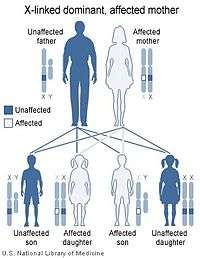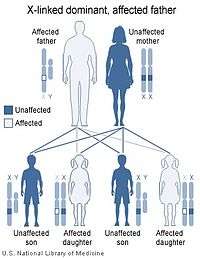X-linked dominant inheritance
X-linked dominant inheritance, sometimes referred to as X-linked dominance, is a mode of genetic inheritance by which a dominant gene is carried on the X chromosome. As an inheritance pattern, it is less common than the X-linked recessive type. In medicine, X-linked dominant inheritance indicates that a gene responsible for a genetic disorder is located on the X chromosome, and only one copy of the allele is sufficient to cause the disorder when inherited from a parent who has the disorder.
X-linked dominant traits do not necessarily affect males more than females (unlike X-linked recessive traits). The exact pattern of inheritance varies, depending on whether the father or the mother has the trait of interest. All daughters of an affected father will also be affected but none of his sons will be affected (unless the mother is also affected). In addition, the mother of an affected son is also affected (but not necessarily the other way round).
Some scholars have suggested discontinuing the terms dominant and recessive when referring to X-linked inheritance due to the multiple mechanisms that can result in the expression of X-linked traits in females, which include cell autonomous expression, skewed X-inactivation, clonal expansion, and somatic mosaicism.[1]
Genetics
As the X chromosome is one of the sex chromosomes (the other being the Y chromosome), X-linked inheritance is determined by the sex of the parent carrying a specific gene and can often seem complex. This is due to the fact that, typically, females have two copies of the X-chromosome, while males have only one copy. The difference between dominant and recessive inheritance patterns also plays a role in determining the chances of a child inheriting an X-linked disorder from their parentage.
Males can only get an X chromosome from their mother whilst females get an X chromosome from both parents. As a result, females tend to show higher prevalence of X-linked dominant disorders because they have more of a chance to inherit a faulty X chromosome.
Inheritance
 |  |
| X-linked dominant inheritance works differently depending upon whether the mother (left image) or father (right image) is the carrier of a gene that causes a disease or disorder. | |
In X-linked dominant inheritance, when the mother alone is the carrier of a mutated, or defective gene associated with a disease or disorder; she herself will have the disorder. Her children will inherit the disorder as follows:
- Of her daughters and sons: 50% will have the disorder, 50% will be completely unaffected. Children of either sex have an even chance of receiving either of their mother's two X chromosomes, one of which contains the defective gene in question.
| |
When the father alone is the carrier of a defective gene associated with a disease or disorder, he too will have the disorder. His children will inherit the disorder as follows:
- Of his daughters: 100% will have the disorder, since all of his daughters will receive one copy of his single X chromosome.
- Of his sons: none will have the disorder; sons do not receive an X chromosome from their father.
| |
If both parents were carriers of a defective gene associated with a disease or disorder, they would both have the disorder. Their children would inherit the disorder as follows:
- Of their daughters: 100% will have the disorder, since all of the daughters will receive a copy of their father's X chromosome.
- Of the sons: 50% will have the disorder, 50% will be completely unaffected. Sons have an equal chance of receiving either of their mother's X chromosomes.
In such a case, where both parents carry and thus are affected by an X-linked dominant disorder, the chance of a daughter receiving two copies of the X chromosome with the defective gene is 50%, since daughters receive one copy of the X chromosome from both parents. Were this to occur with an X-linked dominant disorder, that daughter would likely experience a more severe form.
Some X-linked dominant conditions such as Aicardi Syndrome are fatal to boys, therefore only girls with these conditions survive, or boys with Klinefelter's syndrome (and hence have more than one X chromosome).
List of dominant X-linked diseases
- Vitamin D resistant rickets: X-linked hypophosphatemia
- Rett syndrome
- Most cases of Alport syndrome[2]
- Incontinentia pigmenti[3]
- Giuffrè–Tsukahara syndrome[4]
- Goltz syndrome
- João-Gonçalves syndrome
- Aicardi syndrome
- X-linked dominant protoporphyria[5]
See also
- X-linked hypophosphatemia
- Rett syndrome
- Sex linkage
- Incontinentia pigmenti
- X-linked recessive inheritance
References
- ↑ Dobyns, William B.; Filauro, Allison; Tomson, Brett N.; Chan, April S.; Ho, Allen W.; Ting, Nicholas T.; Oosterwijk, Jan C.; Ober, Carole (2004). "Inheritance of most X-linked traits is not dominant or recessive, just X-linked". American Journal of Medical Genetics. 129A (2): 136. doi:10.1002/ajmg.a.30123. PMID 15316978.
- ↑ Jais, J. P.; Knebelmann, B; Giatras, I; De Marchi, M; Rizzoni, G; Renieri, A; Weber, M; Gross, O; Netzer, K. O.; Flinter, F; Pirson, Y; Dahan, K; Wieslander, J; Persson, U; Tryggvason, K; Martin, P; Hertz, J. M.; Schröder, C; Sanak, M; Carvalho, M. F.; Saus, J; Antignac, C; Smeets, H; Gubler, M. C. (2003). "X-Linked Alport Syndrome: Natural History and Genotype-Phenotype Correlations in Girls and Women Belonging to 195 Families: A "European Community Alport Syndrome Concerted Action" Study". Journal of the American Society of Nephrology. 14 (10): 2603–10. doi:10.1097/01.ASN.0000090034.71205.74. PMID 14514738.
- ↑ http://dermnetnz.org/systemic/incontinentia-pigmenti.html[]
- ↑ Dalal, Ashwin B.; Sarkar, Anujit; Priya, T. Padma; Nandineni, Madhusudan R. (2010). "Giuffrè-Tsukahara syndrome: Evidence for X-linked dominant inheritance and review". American Journal of Medical Genetics Part A. 152A (8): 2057. doi:10.1002/ajmg.a.33505. PMID 20635354.
- ↑ Porphyria#Subtypes